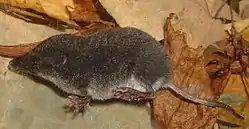尖鼠
Chinese
point (of needle); sharp; shrewd point (of needle); sharp; shrewd; pointed |
rat; mouse | ||
|---|---|---|---|
| trad. (尖鼠) | 尖 | 鼠 | |
| simp. #(尖鼠) | 尖 | 鼠 | |
Pronunciation
Japanese

尖鼠 (togarinezumi): a shrew.
| Kanji in this term | |
|---|---|
| 尖 | 鼠 |
| とが(り) Jinmeiyō |
ねずみ Hyōgaiji |
| kun’yomi | |
Etymology
Compound of 尖り (togari, the 連用形 (ren'yōkei, “continuative or stem form”) of verb 尖る togaru, “to be pointy or sharp”) + 鼠 (nezumi, “mouse, rat”).[1]
Usage notes
- As with many terms that name organisms, this term is often spelled in katakana, especially in biological contexts (where katakana is customary), as トガリネズミ.
References
- Shōgaku Tosho (1988) 国語大辞典(新装版) [Unabridged Dictionary of Japanese (Revised Edition)] (in Japanese), Tōkyō: Shogakukan, →ISBN
- Matsumura, Akira, editor (2006), 大辞林 [Daijirin] (in Japanese), Third edition, Tōkyō: Sanseidō, →ISBN
This article is issued from Wiktionary. The text is licensed under Creative Commons - Attribution - Sharealike. Additional terms may apply for the media files.